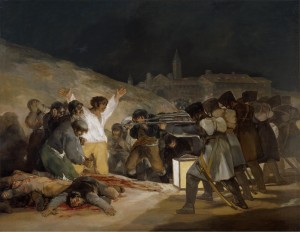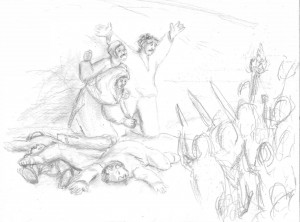Of all the readings we have done this semester, none struck me the way Jo Johnson’s Financial Times article “Radical Thinking” did. Part of our unit on “Being Muslim in contemporary South Asia: the Indian perspective”, it details the systematic discrimination and oppression that Indian Muslims face today and the potentially disastrous consequences for Indian society and safety. In particular, I had a very strong reaction to the violence of the Gujarat Riots. The accounts and stories, which not only described the horrifying bloodshed but also an utter lack of state accountability and trust in the government, disturbed me.
I immediately thought of Goya’s “The 3rd of May 1808”, which brutally depicts the mass execution of Spanish resistance members by Napoleonic troops during the Peninsular War. The image elicits a gut response similar to the one I felt reading about the Gujarat Riots. I wanted to capture that same quality in my creative response. I decided to adapt Goya’s painting to show the massacre that occurred at the Gulberg Society, where many Muslims tried to take refuge, ultimately unsuccessfully. A Muslim former MP Ahsan Jafri had tried to use his government connections to protect those who had taken shelter with him there. Instead, he and the others were viciously butchered by a crowd of 20,000 while police stood by.
There is so much betrayal in that story: betrayal of the secular state’s social contract, where the state promises to protect all citizens from harm; betrayal of the presumption of influence, as Muslims and Jafri himself believed his power was enough; and betrayal of basic human decency, because one would hope that ones’ neighbors and fellow citizens would never chop you limb from limb and then burn the body. I saw that betrayal and desperation on the faces in Goya’s painting and that was what I wanted to convey in my response. The pencil drawing shows Jafri and others pleading for their lives, backed up against a wall by the angry mob with a pile of dead bodies at their feet.
Jo Johnson, “Radical Thinking
 ,” Financial Times, March 31, 2007.
,” Financial Times, March 31, 2007.

The Third of May 1808 in Madrid or “The Executions” by Francisco Goya, 1814. Held by Museo Del Prado, I got this image from their website for personal use.

Post a Comment